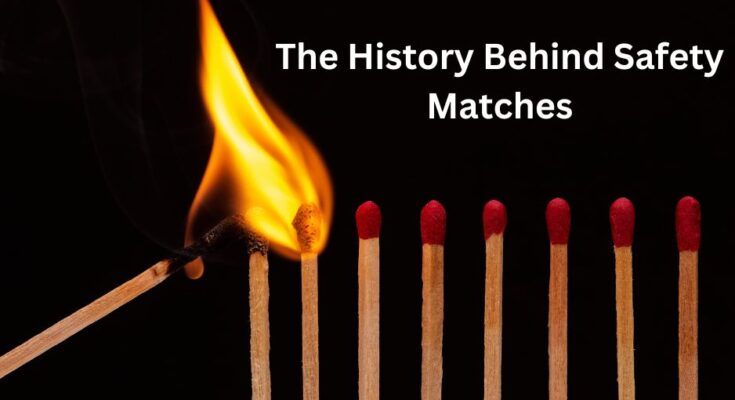Fire is one of the most important discoveries of humanity, and the matchstick is one of the most crucial tools used to start a fire. However, the early versions of matches were hazardous and had the potential to cause dangerous accidents. That’s where safety matches come in – they are designed to be safer and less prone to accidental ignition. But how did safety matches come to be, and what makes them different from traditional matches?
In this blog, we’ll delve into the fascinating history of safety matches, exploring the components that make them a safer option for starting fires. We’ll look closer at the chemistry behind safety matches, specifically the use of red phosphorus in their manufacturing process.
We’ll also examine why safety matches are most commonly made in Tamil Nadu, a region in India that has become a hub for matchstick production. Additionally, we’ll explore the various types of matchsticks available in safety matches and how they differ from traditional matches.
Finally, we’ll compare the safety features of safety matches to those of normal matches, and explain why safety matches are considered a much safer option.
Why are Matches called Safety Matches :
Have you ever wondered why they’re called “safety” matches? We’ll dive into the history behind safety matches, as well as the chemistry and technology that make them a safer option than traditional matches.
First, let’s start with the basics: safety matches were invented in the mid-19th century as a safer alternative to the hazardous traditional matches of the time. The first safety matches used white phosphorus, which is highly toxic and can cause various health problems, including death. In the late 1800s, red phosphorus was discovered as a safer alternative, and it is still used in safety matches today.
So, why are safety matches called safety matches? The safety match name comes from the fact that they are designed to be less prone to accidental ignition than traditional matches. The safety match has two main components: the matchstick and the striking surface. The matchstick contains red phosphorus mixed with powdered glass and binder materials to create a paste. The striking surface is made of a combination of chemicals, including powdered glass and red phosphorus.
When struck against the striking surface, the red phosphorus in the matchstick reacts with the chemicals on the surface, producing enough heat to ignite the match. Because the matchstick only ignites when struck against the proper surface, safety matches are less likely to ignite accidentally.It’s also worth noting that safety matches are typically made in Tamil Nadu, a region in India known for its matchstick production.
Why is Red Phosphorus Used in the Manufacturer of Safety Matches?
Red phosphorus is a key component in the manufacturing of safety matches. It is used instead of the toxic white phosphorus commonly used in early matchstick production. But what makes red phosphorus so important for creating safe matches?
First and foremost, red phosphorus is much safer than white phosphorus. White phosphorus is highly reactive and can ignite easily, making it dangerous to handle. In addition, it is also highly toxic and can cause a range of health problems if ingested or inhaled. In contrast, red phosphorus is less reactive and less toxic to humans.
Another benefit of using red phosphorus in safety matches is that it is more stable than white phosphorus. Red phosphorus is much less likely to react with other materials, making it a safer option for matchstick production.
Red phosphorus can also generate heat when it comes into contact with other chemicals, which is essential for igniting the matchstick. When the matchstick is struck against the striking surface, the red phosphorus reacts with other chemicals, producing enough heat to ignite the match.
In addition, red phosphorus is a versatile material used in various matchstick formulations. It can be mixed with other materials, such as powdered glass and binder materials, to create a paste used to coat the matchstick. This paste helps to control the burn rate of the match, ensuring a steady and controlled flame.
Red phosphorus is a crucial component in the manufacturing of safety matches. It is the safest and more stable alternative to white phosphorus and is able to generate heat when struck against the proper surface, igniting the matchstick. Its versatility also makes it an ideal material for use in matchstick production, allowing for a range of formulations to be created.
Why is Safety Matches most made in Tamil Nadu?
Tamil Nadu is one of the largest producers of safety matches in the world, accounting for a significant portion of global matchstick production. In fact, over 90% of the safety matches produced in India are made in Tamil Nadu. But what makes this region so well-suited to matchstick production, and why are there so many safety matches exporters based in Tamil Nadu?
One reason for the high concentration of matchstick production in Tamil Nadu is the abundance of raw materials. The region is home to many forests that provide the wood necessary for matchstick production. Numerous chemical plants in the region produce the chemicals required for matchstick production, such as red phosphorus and potassium chlorate.
Another reason for the prevalence of matchstick production in Tamil Nadu is the availability of skilled labor. As a result, there is a deep pool of experienced workers skilled in all aspects of matchstick production, from wood cutting to chemical mixing to matchbox packaging. The companies Tamil Nadu specialise in exporting bulk safety matches to countries worldwide, and they have developed a reputation for producing high-quality matches at competitive prices.
How to do Safety Matches Work:
Safety matches are a type of matchstick that is designed to be much safer and easier to use than traditional matches. But how do they work, and what makes them so different from regular matches?
The key difference between safety matches and regular matches is the way that they ignite. Regular matches, also known as strike-anywhere matches, can be ignited by rubbing them against almost any rough surface. This means that they can be accidentally ignited if they are not stored properly, or if they come into contact with a rough surface by accident.
In contrast, safety matches can only be ignited by striking them against a specific surface, known as the striking surface. This surface is typically located on the side of the matchbox or on a separate strip of material that is included with the matches.
The striking surface is coated with a material that contains red phosphorus, which is a key component of safety matches. When the matchstick is struck against the surface, the friction causes the red phosphorus to react with another chemical, typically potassium chlorate, which generates enough heat to ignite the matchstick.
The matchstick itself is made of wood, typically pine or aspen, and is coated with a mixture of chemicals that are designed to help control the burn rate of the match. This coating is made up of a mixture of red phosphorus, powdered glass, and a binder material, which helps to ensure a steady and controlled flame.
Why is Safety Matches a Safe Option to use :
Safety matches are considered to be a much safer option than traditional matches for a number of reasons. We will look at the reasons below:
- Controlled Ignition: Safety matches can only be ignited by striking them against a specific surface, known as the striking surface. This means that they are much less likely to accidentally ignite than traditional matches, which can be ignited by rubbing them against almost any rough surface.
- Safer Chemicals: Safety matches are made using chemicals that are safer and less toxic than those used in traditional matches. For example, red phosphorus is used in safety matches instead of white phosphorus, which can be highly toxic and dangerous.
- Improved Coating: The coating on safety matchsticks is designed to burn slowly and steadily, providing a more controlled flame that is less likely to cause accidental fires. This coating is made up of a mixture of red phosphorus, powdered glass, and a binder material, which helps to ensure a steady and controlled flame.
- Reduced Risk of Burns: Safety matches are designed to burn for a shorter time than traditional matches, which means that there is less risk of accidentally burning yourself when lighting a fire.
What are the types of matchsticks available in Safety Matches
The types of matchsticks available in safety matches are
- Wooden Safety Matches
- Kitchen Safety Matches
- Wax Safety Matches
Conclusion:
In conclusion, the history of safety matches has come a long way since their invention in the mid-19th century. From the use of red phosphorus to the addition of a specific striker surface and improved coating, safety matches have been carefully designed and engineered to provide a safer and more reliable option for lighting fires.
Today, safety matches are widely used around the world, and the industry has grown to include large-scale safety match manufacturers and exporters. With their controlled ignition, safer chemicals, childproof packaging, and reduced risk of burns.




